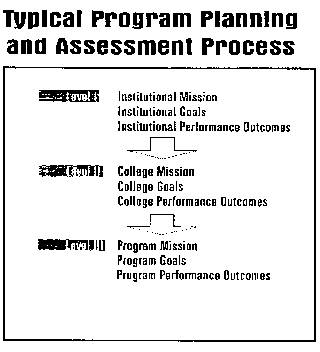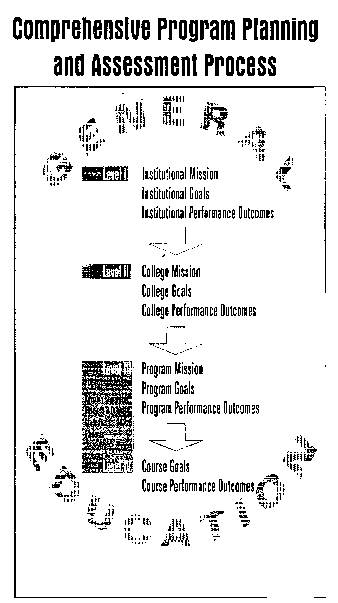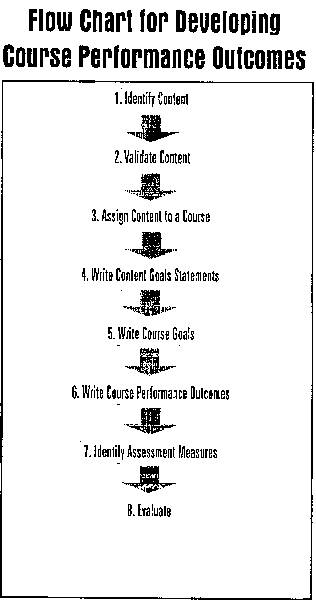|
(pressing HOME will start a new search)
|
|
LINKING COURSE PERFORMANCE OUTCOMES TO PROGRAM GOALS
|
Norma
Jean Andersen Curriculum
and Profession Development North
Dakota State College of Science Wahpeton,
North Dakota |
Kenneth
W. Andersen Department
of Civil Engineering and Construction North
Dakota State University Fargo,
North Dakota |
|
The
Council on Post-Secondary Accreditation in the US Department of
Education has mandated that accrediting agencies use outcome assessments
in evaluating their programs. As a result, the American Council for
Construction Education (ACCE) and the Accrediting Board for Engineering
and Technology (ABET) are including assessment outcomes as part of their
requirements for accreditation. Several articles have been published
dealing with outcome assessment models or program assessment for
construction programs. Each of these articles outlines procedures for
developing outcome assessment based on the mission and strategic plan of
the institution and program. Although these previous articles establish
reasonable and well thought out processes for assessment there still
remains the question: how do the course content and performance outcomes
tie to program goals and objectives? This paper will explain how course
performance outcomes can be related to the program goals and objectives,
while at the same time becoming the foundation for the assessment plan. Keywords:
Outcome
Assessment, Program Assessment, Accreditation, Performance Outcomes,
Curriculum Development, Course Development. |
Introduction
Program or outcome assessment is an
accepted requirement in most academic institutions. The Council on PostSecondary
Accreditation in the US Department of Education has mandated that accrediting
agencies use outcome assessments in evaluating their programs. In addition, the
six regional associations for schools and colleges are requiring outcome
assessments as part of the requirements for granting or renewing accreditation.
As a result, the American Council for Construction Education (ACCE) and the
Accrediting Board for Engineering and Technology (ABET) are including assessment
outcomes as part of their requirements for accreditation. All construction
programs, whether accredited or not, must examine outcome assessments and
develop procedures to meet the assessment requirements.
Several articles have been published
dealing with outcome assessment models or program assessment for construction
programs (Slobojan, 1992, Yoakum, 1994, and Shahbodaghlou, 1994). Each of these
articles outlines the procedures for developing outcome assessment based on the
mission and strategic plan of the institution and program. The program mission
is written, then goals and objectives are developed to drive the achievement of
the mission. Shahbodaghlou (1994) outlines measurable objectives for each
program goal and identifies how the objectives will be measured and data
collected. Youkurn, (1994) concentrates on the process and developing the
criteria for a reasonable yet simple plan. Slobdjan (1991) addresses
establishing outcome assessment at the program level including three categories
of objectives-demographic, attitudinal and performance objectives. Although
these authors establish reasonable and well thought out processes there still remains
the question: how do the course content and performance outcomes tie to
program goals and objectives, ultimately supporting the mission of the
program, college and institution?
Currently, construction faculty across
the nation are developing assessment outcomes for their programs that are part
of the over-all assessment process for the institution. At the same time, many
are developing performance outcomes for their courses to meet accreditation
requirements. In many cases, these two endeavors are viewed as separate,
unrelated activities. This paper will explain how course performance outcomes
can be tied to the program goals and objectives while at the same time becoming
the foundation for the institutional assessment plan.
Program
Planning and Assessment Process
Atypical program planning and
assessment process include the institutional, college, and program levels as
shown in Figure 1. An institutional mission statement is written and a strategic
plan developed. Next, the college and program levels develop their mission,
goals, and outcomes. Most faculty have a limited and superficial involvement in
the process at the college and institutional level. As a result, faculty buy-in
is minimal. Flaws in the system develop when the educators fail to ask how the
program and college level's impact and drive the mission, goals, and objectives
of the institution.
|
|
|
Figure 1. |
If the planning and assessment process
is expanded to the course level as shown in Figure 2, everyone teaching a course
would have the responsibility of connecting what is taught to the mission,
goals, and outcomes of the program, college and institution. The process shown
in Figure 2 also includes two other components. Inform-ation input from advisory committees, students,
graduates and industry is asked for at the program and course levels. Also, the
general education component of the institution that encompasses the whole
educational process is integrated into the mission, goals and performance
outcomes at each level. Thus, each educator has the responsibility to identify
and include comprehensive course content. Likewise, such input from industry,
graduates, and students helps educators keep the content current and pertinent,
thus producing a graduate who meets the mission, goals, and outcomes of the
program, college and institution. The general education component, common to all
institutions, is that aspect of education that develops a well-rounded educated
graduate. These individuals will thrive today and in the future. The general
education component is an integral part of the mission, goals and outcomes at
all levels. In conjunction with the course content, the general education
component produces an individual who will meet the needs and challenges of an
ever-changing world.
|
|
|
Figure 2. |
To ensure that all levels work together
to support and drive the institutional mission we must ask:
1.
What
competencies should students have when they complete a degree?
2.
How
can students demonstrate that they have achieved the competencies at the desired
level of performance?
If these two questions are asked at
each level and asked with increasing vigor at the program and course levels,
course performance outcomes will become an integral part of the entire
assessment process. Before concentrating on the course level, it is important to
revisit the mission, goals and outcomes at the program, college and
institutional levels and make sure these questions are answered.
For the purpose of this paper, the
following program mission statement, program goals, and course content goals
have been developed. These are intended to serve as a generic example to provide
the explanation for the Comprehensive Program Planning and Assessment Process
Model (Figure 2), and the Flow Chart for Developing Course Performance Outcomes
(Figure 3).
|
|
|
Figure 3. |
An example of a program mission
statement is:
The
Construction Management program's mission is to prepare graduates to assume
responsible management positions
in the construction industry.
Examples of program goals are:
1.
Provide
a comprehensive construction management curriculum blending the fundamentals of
construction management, business management, and engineering.
2.
Provide
graduates' opportunities for growth and development in their personal,
professional and public life.
3.
Provide
graduates' opportunities to develop and enhance communication and interactive
skills.
4.
Provide
a curriculum that includes comprehensive general education to develop a
well-rounded individual with insight into social and human issues.
Prior to developing course goals and
performance outcomes, programs must identify and validate content (Figure 3
-Steps I & 2). Active involvement of advisory committees, business and
industry, graduates and students "I ensure program content is current and
pertinent to the needs of the industry. Course content is identified and
communicated as content goal statements. Daniel E. Volgler (199 1) states in his
book Performance Instruction: Planning, Delivering and Evaluating that; Content
goals are a simple and effective means to communicate curricular intent and
specific curricular content (p.3). The content goal should be focused toward the
learner and allows the learner to have a clear picture of the knowledge, skills
and attitudes required to exit the learning experience. Vogler's Curriculum
Pedagogy-Assessment model explained in his book, facilitates instructional
decisions while maintaining great flexibility. The roots of this model can be
traced to Bloom's well-known Taxonomy of Educational Objectives that categorize
learning activities into learning domains and performance levels.
Once the program content is identified,
it can be assigned to the appropriate courses (Figure 3 - Step 3). This process
enables faculty to look across the curriculum to identify overlaps, to spot
voids in the content, to sequence the courses, and to sequence the content
within each course. Once the content goals have been assigned to a course, the
content goal statements can be written (Figure 3 - Step 4). According to Vogler,
the key factors to consider when writing content goals are:
1.
Write
content goals as action statements in the present tense.
2.
Choose
a verb for the action statement, which donate an action, which can be measured.
3.
Limit
one verb per content goal statement.
4.
Focus
on the performance you will require from students in order to demonstrate a
specified level of competency
for a given content area.
5.
Orient
the action verb to the domain and level where you want the learner to exit the
learning experience. It is assumed to exit at a higher level in a domain the
learner must also be able to perform at the lower levels in that domain.
6.
Develop
a goal to communicate a learner product not an instruction method.
7.
Group
content goals into units so that broad performance objectives may be developed
for the course rather than detailed. Details or sub-performance objectives are
developed in the lesson plan.
Examples of content goal statements for
a typical construction course, CNIE 315 Specifications and Contracts are:
1. Explain
construction-contracting methods
2. Analyze
agency relationships
3.
Differentiate organization types
4. Examine
contract disputes and torts
5. Explain
construction-bonding process
6. Interpret
construction contract documents
7. Analyze
construction specification components and organization
8. Analyze technical section components and organization
9. Analyze
contract conditions
10. Prepare
construction specifications
11. Explain
construction insurance
12. Interpret
subcontracts
13. Analyze
contract relationships
14. Explain
dispute resolution processes
15. Recognize
ethical construction issues
The program mission, program goals and the content goals identified for CUE 3 15 Specification and Contracts provide the foundation for the development of the course goals (Figure 3 - Step 5). The question is what should students be able to do upon completion of the course? In this example, the student should be able to have a fundamental knowledge of construction contracts and enough knowledge and skills to write a construction specification. Each course goal should address these issues. Examples of course goals are:
1. Provide students with a fundamental knowledge of construction contracts and their associated liabilities and incentives.
2.
Provide
students with knowledge and skills to interpret and write construction
specifications.
After the course goals are written,
course performance outcomes can be developed to reflect what students must do to
demonstrate their competencies for the specified content goals. Since content
goals are written as simple action statements they are easily converted to
student performance outcomes (Figure 3 - Step 6). Course content goals will
cluster into units of instruction. Performance outcomes are developed by units
or clusters of content goals. The simple, yet crucial question is: what should
students be able to do at the completion of this course to demonstrate their
skills and knowledge? Examples of performance outcomes are:
1.
The
student will identify the components of the contract, interpret the
requirements, and explain the
2.
project
manager's role in the administration of the contract.
3.
The
student will identify the stakeholders and analyze the contractual
relationships.
4.
The
student will explain the organization of the specification and compare and
contrast performance and descriptive specifications.
5.
The
student will prepare a performance and descriptive specification.
6.
The
student will be able to identify ethical construction issues and discuss
attitudes and values related to the ethical issues.
Once the student's performance outcomes have been identified, assessment measures can be developed (Figure 3 Step 7). Assessment measures must evaluate the action specified in the content goals and performance outcomes to effectively assess student achievement. Examples of assessment measures at the course level are:
1.
The
students will be provided a set of contract documents. They will answer
questions about the documents list the contract requirements write a paper to
discuss the project manager's role in the administration of the contract.
2.
The
student will write and prepare both a performance and descriptive specification
based on a set of criteria.
3.
The
student will identify a construction ethics issue and write a paper to discuss
the attitudes and issues involved.
4.
The
student will complete short answer and essay questions to identify the
contractual issues involved, relationships of the contracting parties, and
discuss possible solutions to resolve the dispute presented in a case study.
These four assessment measures tie directly to the five course performance outcomes and the two course goals previously identified. The assessment measures and course goals resulted from the content goals developed for the Construction Specifications and Contracts course. Construction specifications and contracts are an intricate part of construction management fundamentals identified in Program Goal 1. Performance outcomes, requiring students to think, organize and write in response to a given assignment, supports the general education components in Program Goals 3 and 4. Performance outcomes, dealing with construction ethics, attitudes and values, support: the growth and development of the individual identified in Program Goal 2. These in turn support the program mission statement that stresses that graduates must be prepared to assume responsible positions in the construction industry. At each stage of the process, student expectations have been addressed and specified. This process keeps the focus on the mission, goals and performance outcomes of the program, college, and institution.
The final step in the process for
developing course performance outcomes is evaluation (Figure 3 - Step 8). The
evaluation process insures that course content and student competencies are
appropriate and at the same time continue to support the mission and goals of
the institution, college and program while meeting the needs of the industry.
Summary
Expanding the program planning and
assessment process to include course goals and performance outcomes evolved
while addressing the requirements in the ACCE accreditation self study. This
report requires that the syllabus state the course objectives in relation to the
program goals and objectives. The requirement on the surface appears to be
simple but becomes more complex as one tries to specifically tic the course
content to specific goals of the program, college, and institution.
The Planning and Assessment Model
(Figure 2) develops a complete planning and assessment process that transcends
assessment beyond the program level to the specific course and student
performance outcomes. The model provides a mechanism for faculty and programs to
evaluate individual course content as well as content across the curriculum in
relation to the needs of the construction industry. In addition, this process
becomes a tool for improving teaching and learning. Faculty must answer whether
or not the content identified does in fact help the student achieve competencies
identified by the program and the industry. Focusing teaching and learning in
this way eliminates nonessential material and helps facilitate the learning
experience. Students benefit from this process because the intent of the content
and requirements for satisfactory performance arc clearly specified. Performance
outcomes with assessment measures identified for each course is the foundation
necessary to develop and implement a comprehensive assessment plan for the
institution.
Reference
Marzano, R.J., Pickering, D. &
McTighe, J. (1993). Assessing student outcomes, performance assessment using the
dimensions of learning model. Association for Supervision and Curriculum
Development. Alexandria, VA.
Shahbodaghlou, F & Rebholz, F.E.
(1994). Outcome assessment model for a construction program. Proceedings of the
30th Annual Conference Associated Schools of Construction (pp. 87-97) Bradley
University. Peoria, Illinois.
Slobojan, J. (1992). Implementing
outcome assessment for program accreditation. Proceedings of the 28th Annual
Conference Associated Schools of Construction (pp. 29-3 3) Auburn University.
Auburn, Alabama.
Vogler, D.E. (1991). Performance
instruction: planning, delivering, evaluating. Instructional Performance
Systems, Inc. Eden Prairie, MN.
Yoakum, B. (1994). Program assessment
good management practice. Proceedings of the 30th Annual Conference Associated
Schools of Construction (pp. 191-200) Bradley University. Peoria, Illinois.



